
Little creek, big impact
Twice as many birds at Putah Creek after water restored
A small restored area is having a big impact on regional birds, fish and animals, according to a study published in the journal Ecological Restoration by the University of California, Davis.
Just 4 miles west of UC Davis’ main campus sits a sliver of wildness called Putah Creek Riparian Reserve. On a recent spring day, below a canopy of valley oaks and eucalyptus trees came a twittering of chirps, trills and quacks.
Two kingfishers crisscrossed the creek, calling to each other. Woodpeckers drilled into tree bark. A house wren assertively defended his nest box from any real estate competitors. In the distance, a train whistle blew, and an airplane took off — reminders of the urban world just up the road.
Just add water
About 20 years ago, this gem of a green oasis was largely a dry ditch, more likely to be used as a dumping ground for rusty car parts and washing machines than a haven for wildlife or humans. Then in 2000, a lawsuit brought about the Putah Creek Accord, which mandated year-round flows for the creek to help protect fish and habitat. When the water returned, so did the bugs, the fish and the birds.
A lot of birds.
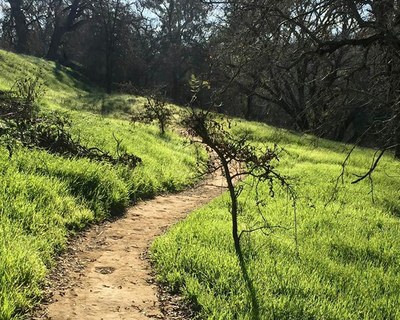
“Since 1999, the year before the water returned, the density of the breeding birds on lower Putah Creek has more than doubled,” said lead author Kristen Dybala, a postdoctoral scholar at UC Davis during the time of the study and now a senior research ecologist with nonprofit Point Blue Conservation Science. “That’s just kind of incredible to me.”
For the study, researchers analyzed about 14 years of bird survey data collected along a 23-mile area of the creek. It found that the average density of birds increased from roughly 30 birds per acre in 1999 to 84 birds per acre in 2012.
“Since 1999, the year before the water returned, the density of the breeding birds on lower Putah Creek has more than doubled.” –lead author Kristen Dybala
Riparian birds return
Those species aren’t just the birds one would expect in urban environments, such as crows and scrub jays. Less common riparian and woodland birds, such as yellow warblers, spotted towhees and song sparrows are visiting in increasing numbers, which is a promising sign for the health of this ecosystem.
The researchers also found that the increase could not be explained by other regional factors or just by the addition of nest boxes along the creek.
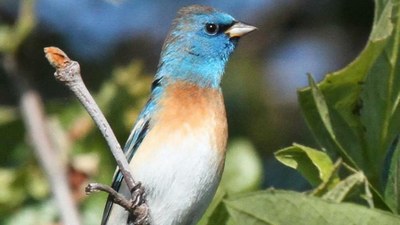

“These are benefits specifically to riparian birds, which depend on this streamside habitat and have been less common along Putah Creek,” Dybala said. “Some of them nest on the ground; some require tree cavities; some require shrubs. If you’re looking at this whole group and they’re all improving, then you have a better idea that the entire ecosystem is functioning well.”
Beyond the water’s edge
The creek is narrow, no wider than a two-lane highway at most. But while its footprint is small, its impact stretches well beyond the water’s edge. Separate UC Davis research by graduate student Robert Walsh indicates that tree swallows up to a quarter mile away use Putah Creek as one of their favorite dining spots. Isotopic analysis of their diet showed that more than two-thirds of the insects they eat come from Putah Creek.
“The insects are an amazing food source around the creek,” said this study’s senior author Melanie Truan, a staff research associate with the UC Davis Museum of Wildlife and Fish Biology. “It’s the pulse of this insect life living along the creek — if you improve the instream environment, you improve it for both aquatic and terrestrial life.”
“When you step down into the reserve, you feel like you’re in a whole different world.” –Melanie Truan
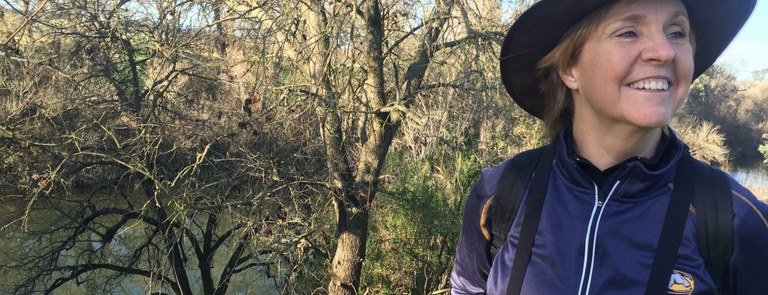
A model for neglected streams
The success at Putah Creek could be replicated at other neglected streams, the authors note. Such restoration efforts hold multiple benefits for people and wildlife.
Beyond the return of fish and birds, biologists conducting the survey have observed a host of other wildlife returning to the creek, from mink and beaver to river otters, bobcats, coyotes, and even an occasional bear.
The potential for groundwater recharge, carbon sequestration, erosion and flood control, improved water quality, and a revived community greenspace benefits humans, as well.
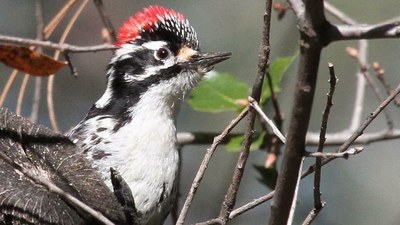
“Putah Creek is this little relic of what used to be in the valley. It’s kind of amazing that it’s still there. If it hadn’t been for the people who fought to protect the water in it, it would just be a ditch,” said Truan, noting the influence of the Putah Creek Council and its volunteers on its restoration. “When you step down into the reserve, you feel like you’re in a whole different world. It really is a singularly unique place that engenders a lot of really wonderful feelings.”
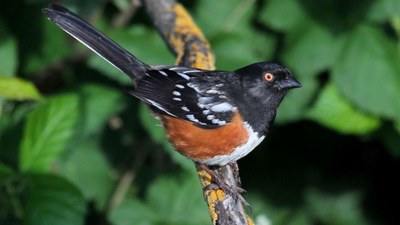
Room for improvement
The study notes that there is room for improvement. The downstream sites along Putah Creek are not attracting as much wildlife as the upstream sites, which mirrors trends in the fish community there. Cooler water entering the stream warms as it moves downstream, resulting in more invasive fish in those areas. More work is needed to connect existing patches of habitat together so that downstream sites can enjoy the same benefits to wildlife as the upstream sites.
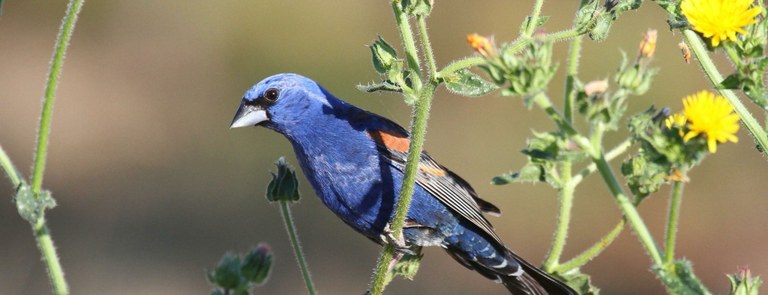
Blue grosbeaks, such as this adult male, are neotropical migrants. They winter in Central America and return each spring to nest on the lower reaches of the creek. (Andrew Engilis, Jr./ UC Davis Museum of Wildlife and Fish Biology)
The study’s additional co-authors include Andrew Engilis Jr., John Trochet and Irene Engilis from the UC Davis Museum of Wildlife and Fish Biology.
The research was funded by Solano County Water Agency, Putah Creek Council, CALFED Bay-Delta Program, U.S. Environmental Protection Agency STAR program, California Department of Water Resources, U.S. Fish and Wildlife Service, California Department of Fish and Wildlife, Department of Wildlife, Fish, and Conservation Biology, Selma Herr Fund for Ornithological Research, the UC Davis Museum of Wildlife and Fish Biology, and the cities of Davis and Winters.
Podcast by Kat Kerlin and produced by Amy Quinton
Related Stories
Hummingbird Health: Appreciate the Little Things
For the past six years, Kusch, a UC Davis senior lecturer emeritus of French and comparative literature, has been opening his garden to the UC Davis Hummingbird Health and Conservation Program. The group, including the University of Wyoming, is the only collaborative program in the nation focused on hummingbird health and genetics.
Nigiri Project Mixes Salmon and Rice Fields for Fifth Year on Floodplain
An annual experiment to “plant” salmon in Yolo County rice fields aims to better explain how floodplains support strong salmon populations. Dubbed the “Nigiri Project” for its sushi-like marriage of fish and rice, the research is a collaborative project among the UC Davis Center for Watershed Sciences, the California Department of Water Resources and nonprofit organization California Trout.
Climate Change and Habitat Conversion Combine to Homogenize Nature
In northwest Costa Rica, the study’s authors surveyed birds and plants at 120 sites that included rainforests, dry forests and farmland to determine how habitat conversion and climate-change-induced droughts affect tropical wildlife. They found that different bird species thrive in drier versus wetter areas of forests. In farmlands however, birds associated with dry sites were found everywhere, even in the wettest sites.